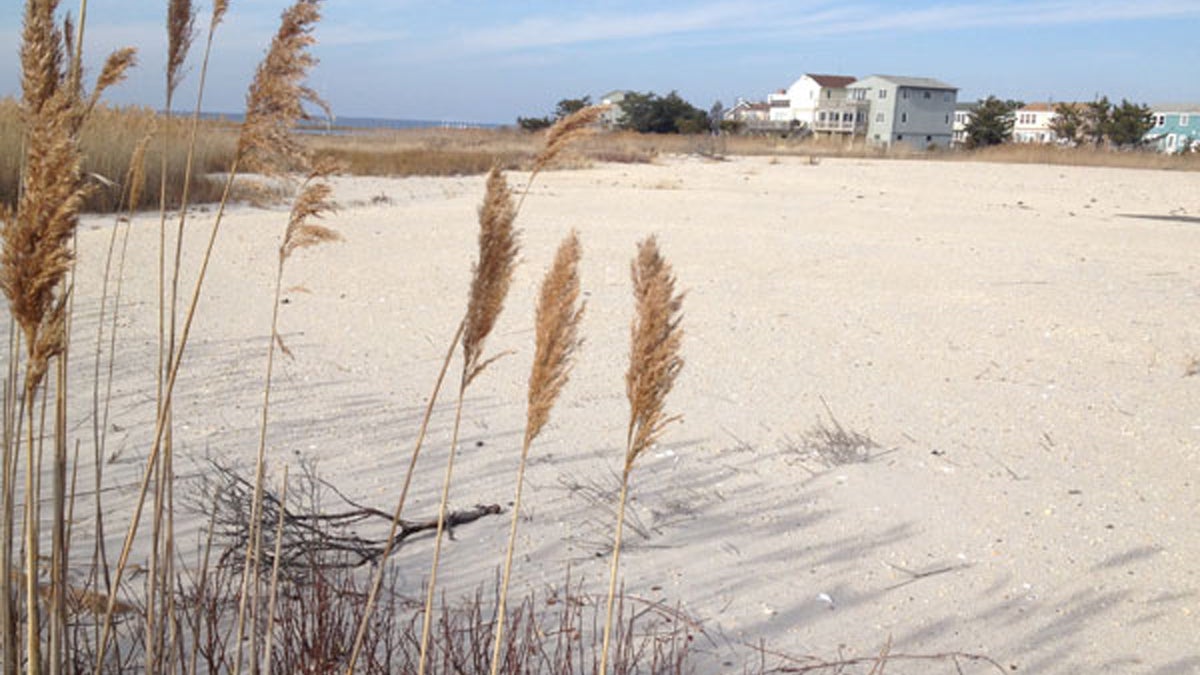Wetlands development plans in Holgate worry environmentalists, residents of LBI

A section of beach and dunes in the Holgate section of Long Beach Township on Long Beach Island. (Image via NJ Spotlight)
Amid concerns that more building could increase vulnerabilities to storms, developer pledges to preserve land.
Doug Shearer and his wife moved into their home on the southern tip of Long Beach Island just three months before Hurricane Sandy hit. It’s a modern-looking, newly rebuilt beach house on a quiet street in the Holgate section of Long Beach Township, just a short walk from both the beach and the bay. But despite their proximity to the water, they made it through the storm with only about 6 inches of flooding on their lower level.
“We attribute a lot of that to this tract of wetlands that was right across from us,” Shearer said, pointing to a 24-acre field that’s mostly covered with reed grass and shrubbery.
“It took the energy out of the waves that came through on the large sections of dunes that did breach and also sucked up and had a sponge effect on the back-bay high tides that came in after that. Whenever we thought we had it bad, we would just come out here and take a walk a mile either way and see the devastation that took place for the folks who didn’t live by the wetlands. It was absolutely a lifesaver!”
For Shearer, the lesson is clear.
“We may have gone one step too far with development,” he said. “I’ve been coming to this island since I was 17 years old, and to see the growth and the overdevelopment has been somewhat sobering.”
Now he believes that battle has come to his own backyard, with the owners of this wetlands — one of the few remaining untouched plots of property on Long Beach Island — putting it on the market. After sediment from Sandy filled in a portion of the property, the owners sought and received initial permission from the state to remove its wetlands classification, potentially opening the door to residential construction.
A real-estate developer working with the owners has pledged to protect the land, but some residents like Shearer remain suspicious. Whatever the eventual outcome, the events have renewed long-standing concerns about costal construction, environmental preservation, and vulnerabilities in the most densely populated state in the nation. Some advocates also say New Jersey needs a better plan to protect the precious little undeveloped shoreline it has left.
With its tightly packed, highly developed coastline, many environmentalists and planning experts say the Jersey Shore was basically primed for disaster two years ago, when Sandy made landfall.
Ocean County — where Holgate is located, and which experienced some of the worst damage — has historically been the fastest-growing county in the state, with its population increasing tenfold between 1950 and 2010. So it came as little surprise when New Jersey surpassed Texas a few months ago, in the aftermath of Sandy, to become second in the nation in terms of total flood insurance payouts, going back to 1978.
On LBI, most of the development occurred in the 1950s and 1960s, when it was common practice for people to acquire wetlands and simply fill them in. That was the case when members of the Colmer family purchased this 24-acre lot in 1950 for $5,750. At the time, there was talk of building additional bridges to the island (there was only one), and the family considered constructing a movie theater on the land.
Neither of those things ever happened, however, and the land sat vacant for years. Then state environmental laws took effect in the early 1970s, protecting wetlands like this from development.
“People ask me a lot of times if this land over here is buildable,” said Mark Davies, a local builder who’s now working with four descendants of the original Colmer family owners.
“I’ll tell them, ‘Under the current regulations it’s not.’ But regulations can change, facts can change, the land can change. So you never say ‘never.’”
During Sandy, Davies says, floodwaters washed sand from the nearby beach and dunes onto two of the 24 acres, permanently altering the landscape. So he had it surveyed and presented a report of his findings to the state Department of Environmental Protection. The DEP then conducted its own surveys before issuing an initial ruling last November in Davies’ favor.
“Based on these investigations, the Department has determined that a portion of the coastal wetlands located on the property has been lost as a result of overwash from Superstorm Sandy,” the notice said. “This overwash altered the topographic elevations of the site and vegetation such that a portion of the site no longer meets the definition of a coastal wetland pursuant to the Wetlands Act of 1970.”
“We’re not making any evaluation of developability,” DEP spokesman Larry Hajna said, noting that his office would still have to approve any building applications. But he added, “There’s nothing scientifically that would make that constitute a wetlands anymore, so scientifically, we need to make that change.”
In order to officially amend its coastal wetlands maps, the state still needs to hold a public-comment period over the coming months, but in the eyes of Davies, that’s a mere formality.
While getting the wetlands designation removed from these two acres would overcome the biggest hurdle to let him build on this section of the property, Davies says building isn’t actually his intent. Instead, he’s under contract to purchase the property from the current owners and then resell it to the Trust for Public Land, a national group that wants to preserve it.
It’s an attractive offer, says Anthony Cucchi, TPL’s state director for New Jersey and Pennsylvania.
“A lot of our work over the years has been more on the mainland,” he said. “This is one of the few opportunities to acquire property on a barrier island.”
To complete the deal, however, TPL needs to look at how much the land is worth. That’s where the DEP’s determination comes into play. As mere wetlands, the property wouldn’t have much monetary value. So in order to get a better price, Davies has gone about creating commercial value by making it suitable for building. Petitioning the state to revise its maps was the first step.
Then a few weeks ago, he got tentative approval from the Long Beach Township Land Use Board to subdivide the land into a dozen residential lots. It’s a complicated real estate transaction, and some locals like Doug Shearer are worried the plan might not work.
“Mr. Davies wants to sell the land to the Trust for Public Land,” he explained. “The Trust for Public Land doesn’t have the money, so they have to reach out to the Ocean County Natural Land Trust Fund. And if any of those dominoes don’t fall through, now we have a piece of land that has been deemed — at least preliminarily — developable, which is a bit scary for those of us who live around here. We’ve seen some of the mistakes made in the past, where we’ve built on land that shouldn’t have been built on.”
Kyle Gronostajski with Alliance for a Living Ocean, a local environmental group, agrees the Jersey Shore needs less development, not more.
“To see people wanting to develop land like this in an area that is so vulnerable doesn’t really make sense,” he said. “It says that we really didn’t learn anything from Sandy, that we’re going to keep staying our course, doing things as they were, and it leads to the potential for more devastation in the future.”
To Gronostajski, the potential for this land to be developed is a perfect example of why the state needs stricter rules to protect the environment.
“I think it’s really important for everyone to realize that we don’t have a definitive and clear coastal management plan in New Jersey and much of the country as well,” he said. “To allow people to just continuously build and continuously develop any area they want on islands like this that we know are fragile, that we know are susceptible to sea level rise and susceptible to future storms is irresponsible. And it’s important to make sure that everyone up and down the coast, whether it’s New Jersey or any other state, realizes that there are people interested in protecting these, and it’s not just build, build and develop everything in sight.”
Other critics point out that homes in the neighborhood adjacent to the wetlands can sell for up to a million dollars, so they fear that if the preservation plan were to go awry, elected officials might be lured by the added tax revenue new development would bring.
They’re also concerned that the Trust for Public Lands might not be able to round up the funds necessary to purchase the property, but TPL’s Cucchi downplayed such worries.
“Without a doubt, this land is much more valuable on a per-acre basis than inland land,” he said. “Without a doubt, it’s more valuable real estate. But we are very optimistic that there will be support from the county and other sources.”
As a developer, Mark Davies said he understands that some folks are skeptical of his intentions, but he’s convinced they’ll come around once they realize that he’s on their side.
“I can see them complaining and arguing now, cause they don’t necessarily know what goes on, and people get emotional, and that’s just the way it is,” he said. “But we really are all trying to do the same thing and all trying to get to the same spot, and we’re real close.”
“My daughter’s an environmental scientist, and she’s very happy that we’re moving forward in this direction,” he added. “It’s unusual to be in this spot where you’re doing a real good thing, and I think everybody’s going to win out of it.”
Sandy caused a lot of damage to the island, Davies said, but if the sand that washed up on this land enables its owners to sell it for preservation, this might just be a rare instance where people actually benefit from the storm.
______________________________________________
NJ Spotlight, an independent online news service on issues critical to New Jersey, makes its in-depth reporting available to NewsWorks.
WHYY is your source for fact-based, in-depth journalism and information. As a nonprofit organization, we rely on financial support from readers like you. Please give today.




